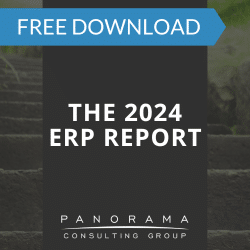How do you decide which ERP system to implement when internal bias and vendor enthusiasm threaten to sway you? The best way to evaluate systems is to weigh the strengths and weaknesses of each according to the following ERP selection criteria.
ERP Selection Criteria
1. Deployment Options
Most ERP vendors are heavily investing in cloud technology, but functionality is still limited compared to on-premise solutions. While vendors are working on providing more robust functionality, the novelty of the cloud is still intimidating to many organizations.
This doesn’t mean every organization should select an on-premise solution. In the future, some ERP vendors may stop developing or even supporting their on-premise products, forcing customers to transition to the cloud, which is more complex and time-consuming than vendors claim.
2025 Clash of the Titans
SAP, Oracle, Microsoft, and Infor each have a variety of systems that can support data-driven decision-making. We surveyed customers of these four vendors to find out what their selection and implementation process was like.
2. Scalability
Software scalability refers to a system’s ability to handle an increasing amount of work and increasing number of users.
When evaluating options, it’s important to know which products and deployment models can continuously scale to support your growing business. In other words, if your customer base increases, the software should be able to continue functioning at top capacity.
For example, it should continue to provide real-time data despite the increase in data volume.
Scalability can be expensive for some on-premise solutions. You might need to purchase additional servers to support the increased workload. We recommend asking vendors what their products can support out-of-the-box and if they can be scaled.
3. Technical Fit
ERP vendors have different functional strengths that make them well-suited for certain industries. While industry focus is a strong indicator of technical fit, your business requirements should have the final say.
If you take the time to define your ERP requirements, you can ask vendors to demonstrate specific functionality. You’re not expecting too much by asking a vendor to demo their ERP system based on your requirements rather than presenting a canned sales demo.
In addition to sharing your business requirements with vendors, you should also give them access to your subject matter experts to ensure vendors fully understand your business.
While no ERP system can address every possible business requirement, you should look for a system that addresses your highest priority requirements. In addition, you should determine which processes should be standardized based on ERP functionality, and which processes are competitive differentiators that could require software customization.
4. References
Vendors will make many claims about their system’s capabilities and ease of use. If you want to validate these claims, you should request references, so you can ask previous customers about their experience.
What functionality did they implement, and did they achieve the desired results? Did the vendor offer ongoing support and training?
References should be from organizations similar to your own that have implemented similar functionality. If you’re considering cloud ERP, ask for references that have deployed their software in the cloud.
5. Return on Investment
While total cost of ownership is a common consideration during ERP selection, ROI is even more important. If you choose an ERP solution based on ROI rather than total cost of ownership, you will realize more business benefits.
The first step is developing a business case that quantifies the benefits you expect. This will guide you in improving your processes and defining your business requirements. ERP software is more likely to deliver a high ROI if it supports your optimized, future-state processes.
6. Product Viability
Do you know the long-term outlook of the ERP software you’re evaluating? While SAP and Oracle aren’t likely to go out of business any time soon, they may stop supporting certain products.
It’s also worth knowing where a vendor plans to invest their R&D in the future, as it’s your responsibility to select a product that will support your organization in the long-term.
You should conduct industry research to determine if a software product is on par with its competition. If not, the vendor may be planning to discontinue the product. In the short-term, product stagnation hurts your business as you’ll spend a fortune on customization just to remain innovative.
Other Selection Considerations
Before beginning the ERP selection process, you should define a digital strategy. What are the pain points of your current IT infrastructure, and what needs to change to support your organizational objectives?
Even if you select one of the top ERP systems, you won’t transform your organization unless you focus on your people and processes.
Our ERP consultants can walk you through the full selection process, which includes activities related to organizational alignment and business design. We’ll ensure you select technology that lasts your organization for the next five to ten years.













